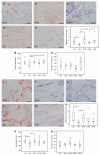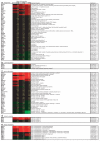Neurovascular and neuroimmune aspects in the pathophysiology of rosacea
- PMID: 22076328
- PMCID: PMC3704331
- DOI: 10.1038/jidsymp.2011.6
Neurovascular and neuroimmune aspects in the pathophysiology of rosacea
Abstract
Rosacea is a common skin disease with a high impact on quality of life. Characterized by erythema, edema, burning pain, immune infiltration, and facial skin fibrosis, rosacea has all the characteristics of neurogenic inflammation, a condition induced by sensory nerves via antidromically released neuromediators. To investigate the hypothesis of a central role of neural interactions in the pathophysiology, we analyzed molecular and morphological characteristics in the different subtypes of rosacea by immunohistochemistry, double immunofluorescence, morphometry, real-time PCR, and gene array analysis, and compared the findings with those for lupus erythematosus or healthy skin. Our results showed significantly dilated blood and lymphatic vessels. Signs of angiogenesis were only evident in phymatous rosacea. The number of mast cells and fibroblasts was increased in rosacea, already in subtypes in which fibrosis is not clinically apparent, indicating early activation. Sensory nerves were closely associated with blood vessels and mast cells, and were increased in erythematous rosacea. Gene array studies and qRT-PCR confirmed upregulation of genes involved in vasoregulation and neurogenic inflammation. Thus, dysregulation of mediators and receptors implicated in neurovascular and neuroimmune communication may be crucial at early stages of rosacea. Drugs that function on neurovascular and/or neuroimmune communication may be beneficial for the treatment of rosacea.
Figures






References
-
- Amălinei C, Căruntu ID, Giuşcă SE, et al. Matrix metalloproteinases involvement in pathologic conditions. Rom J Morphol Embryol. 2010;51:215–28. - PubMed
-
- Amerini S, Ziche M, Greiner ST, et al. Effects of substance P on mesenteric lymphatic contractility in the rat. Lymphat Res Biol. 2004;2:2–10. - PubMed
-
- Aroni K, Tsagroni E, Kavantzas N, et al. A study of the pathogenesis of rosacea: how angiogenesis and mast cells may participate in a complex multifactorial process. Arch Dermatol Res. 2008;300:125–31. - PubMed
-
- Aroni K, Tsagroni E, Lazaris AC, et al. Rosacea: a clinicopathological approach. Dermatology. 2004;209:177–82. - PubMed
MeSH terms
Substances
Grants and funding
LinkOut - more resources
Full Text Sources
Other Literature Sources
Medical

